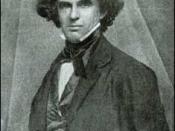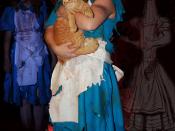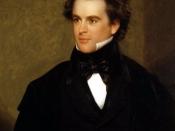With the Revolutionary War only sixty-eight years removed, aristocratic thinking is being challenged by the new democratic mind-set. During this turbulent, yet exciting, growth spurt in American history, Nathaniel Hawthorne publishes The House of the Seven Gables (1851). His masterful use of binary characters subtlety argues for the wholesomeness of plebeian democratic values rather than keeping the patrician aristocratic power structure. Hawthorne creates several characters that are in binary opposition to one another. Among other themes, these characters represent the theme of the rise of the plebeian over the ashes of the patrician.
The scene is first set with Colonel Pyncheon and Matthew Maule. The Colonel is a puritan aristocrat who encourages the persecution and subsequent hanging of Matthew Maule for witchcraft during the Salem Witch Trials in order to lay claim to the Maule property--the only land that has a stream running through it. In this first battle of the patriarch versus the plebeian, it is the patriarch who wins--or does he?
The legend goes on to claim that at Matthew Maule's hanging, he curses the Colonel saying, "God will give him blood to drink!" (358) The Colonel later hires Maule's son, Thomas, to build the Seven Gabled House on top of Maule's old cabin.
Then, in good old aristocratic fashion, he throws a house warming party for the whole town but seemingly departs from his patriarchic position by remaining absent even when the Lieutenant Governor arrives. It is discovered that the Colonel is in his study--dead--with "blood on his ruff, and ...his hoary beard ...saturated with it" (364). Thus, Hawthorne sets the stage with the power of a plebeian curse at least appearing to come true.
The main tale takes place one hundred and sixty years after the Colonel's death, but in a flashback to thirty-seven...


